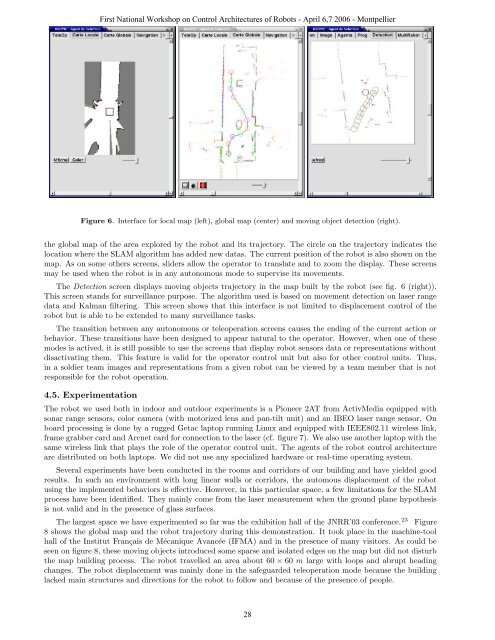Pleading for open modular architectures - Lirmm
Pleading for open modular architectures - Lirmm
Pleading for open modular architectures - Lirmm
Create successful ePaper yourself
Turn your PDF publications into a flip-book with our unique Google optimized e-Paper software.
Figure 6. Interface <strong>for</strong> local map (left), global map (center) and moving object detection (right).<br />
the global map of the area explored by the robot and its trajectory. The circle on the trajectory indicates the<br />
location where the SLAM algorithm has added new datas. The current position of the robot is also shown on the<br />
map. As on some others screens, sliders allow the operator to translate and to zoom the display. These screens<br />
may be used when the robot is in any autonomous mode to supervise its movements.<br />
The Detection screen displays moving objects trajectory in the map built by the robot (see fig. 6 (right)).<br />
This screen stands <strong>for</strong> surveillance purpose. The algorithm used is based on movement detection on laser range<br />
data and Kalman filtering. This screen shows that this interface is not limited to displacement control of the<br />
robot but is able to be extended to many surveillance tasks.<br />
The transition between any autonomous or teleoperation screens causes the ending of the current action or<br />
behavior. These transitions have been designed to appear natural to the operator. However, when one of these<br />
modes is actived, it is still possible to use the screens that display robot sensors data or representations without<br />
disactivating them. This feature is valid <strong>for</strong> the operator control unit but also <strong>for</strong> other control units. Thus,<br />
in a soldier team images and representations from a given robot can be viewed by a team member that is not<br />
responsible <strong>for</strong> the robot operation.<br />
4.5. Experimentation<br />
First National Workshop on Control Architectures of Robots - April 6,7 2006 - Montpellier<br />
The robot we used both in indoor and outdoor experiments is a Pioneer 2AT from ActivMedia equipped with<br />
sonar range sensors, color camera (with motorized lens and pan-tilt unit) and an IBEO laser range sensor. On<br />
board processing is done by a rugged Getac laptop running Linux and equipped with IEEE802.11 wireless link,<br />
frame grabber card and Arcnet card <strong>for</strong> connection to the laser (cf. figure 7). We also use another laptop with the<br />
same wireless link that plays the role of the operator control unit. The agents of the robot control architecture<br />
are distributed on both laptops. We did not use any specialized hardware or real-time operating system.<br />
Several experiments have been conducted in the rooms and corridors of our building and have yielded good<br />
results. In such an environment with long linear walls or corridors, the automous displacement of the robot<br />
using the implemented behaviors is effective. However, in this particular space, a few limitations <strong>for</strong> the SLAM<br />
process have been identified. They mainly come from the laser measurement when the ground plane hypothesis<br />
is not valid and in the presence of glass surfaces.<br />
The largest space we have experimented so far was the exhibition hall of the JNRR’03 conference. 23 Figure<br />
8 shows the global map and the robot trajectory during this demonstration. It took place in the machine-tool<br />
hall of the Institut Français de Mécanique Avancée (IFMA) and in the presence of many visitors. As could be<br />
seen on figure 8, these moving objects introduced some sparse and isolated edges on the map but did not disturb<br />
the map building process. The robot travelled an area about 60 × 60 m large with loops and abrupt heading<br />
changes. The robot displacement was mainly done in the safeguarded teleoperation mode because the building<br />
lacked main structures and directions <strong>for</strong> the robot to follow and because of the presence of people.<br />
28

















